Height Weight Bmi Chart
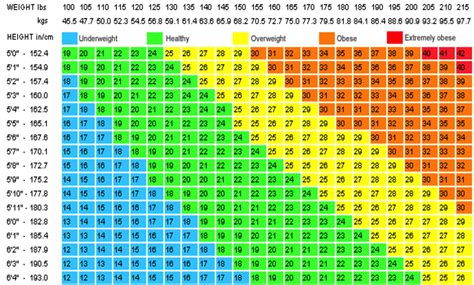
The Height, Weight, and BMI (Body Mass Index) chart is a valuable tool for assessing an individual's overall health and understanding their weight status relative to their height. This chart provides a simple yet effective way to categorize individuals into different weight categories, helping them and healthcare professionals gauge potential health risks and make informed decisions regarding diet, exercise, and lifestyle choices.
Understanding the Height, Weight, and BMI Chart
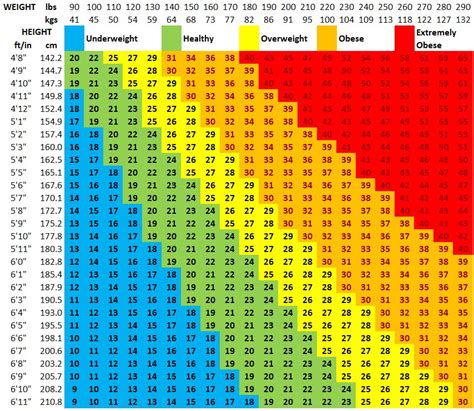
The Height, Weight, and BMI chart, often referred to as a BMI chart, is a graphical representation that depicts the relationship between an individual’s height and weight. It categorizes individuals into different weight categories based on their BMI, which is a calculation that considers both height and weight.
BMI is calculated using the formula: BMI = Weight (kg) / Height (m2). This index provides a standardized measure to assess an individual's weight status and is widely used by healthcare professionals and fitness experts.
Interpreting the BMI Chart
The BMI chart is typically divided into columns representing height and rows representing weight, creating a grid-like structure. Each intersection of a height column and a weight row corresponds to a specific BMI value. Here’s how to interpret the chart:
- Underweight: If your BMI falls below the underweight range on the chart, it suggests you may have a low body weight relative to your height. This could indicate a need for weight gain or further assessment to determine the underlying cause.
- Healthy Weight: A BMI within the healthy weight range indicates that your weight is proportional to your height. This is generally considered the ideal range, associated with reduced health risks.
- Overweight: Being in the overweight category means your BMI is higher than the healthy weight range. This may increase the risk of certain health conditions and often prompts recommendations for weight loss and lifestyle adjustments.
- Obese: The obese category on the BMI chart signifies a significantly high BMI, which is associated with a higher risk of various health issues. Weight loss and lifestyle interventions are typically recommended to mitigate these risks.
| Weight Category | BMI Range |
|---|---|
| Underweight | Below 18.5 |
| Healthy Weight | 18.5 - 24.9 |
| Overweight | 25.0 - 29.9 |
| Obese | 30.0 and above |
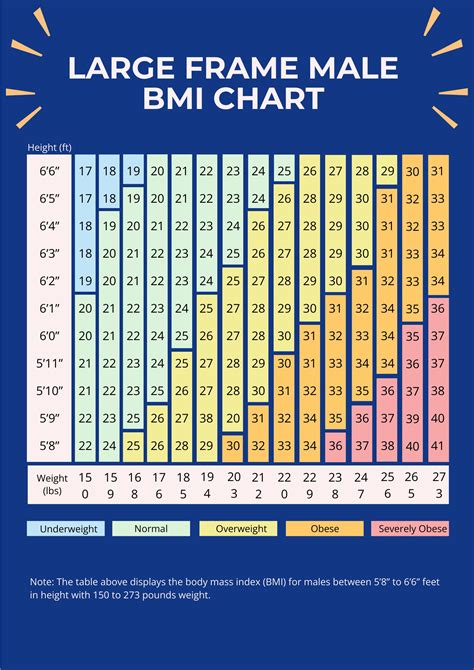
It's important to note that while the BMI chart provides a useful starting point, it may not accurately represent body composition in all individuals. Factors like muscle mass, bone density, and body fat distribution can influence the accuracy of BMI as a measure of overall health. For more detailed assessments, individuals should consult with healthcare professionals who can provide personalized advice and guidance.
Using the Height, Weight, and BMI Chart for Self-Assessment
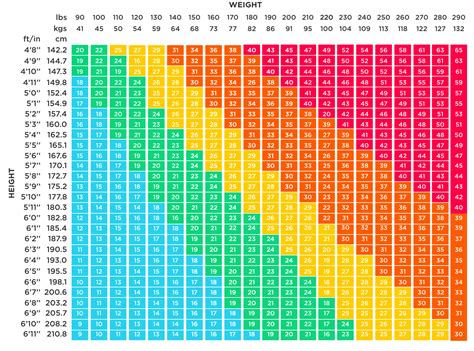
The Height, Weight, and BMI chart is an accessible tool that individuals can use to gain insights into their weight status. Here’s how you can use the chart for self-assessment:
Step 1: Measure Your Height and Weight
To begin, accurately measure your height and weight. Ensure you stand tall and straight for height measurement, and use a reliable scale for weight measurement. Record these values in kilograms and meters for consistency.
Step 2: Locate Your Height on the Chart
Locate the column on the chart that corresponds to your height. This will be the starting point for your assessment.
Step 3: Identify Your Weight Range
Move across the chart to the row that aligns with your weight. This will give you a rough idea of your weight category based on your BMI.
Step 4: Interpret the Results
The intersection of your height column and weight row will provide your estimated BMI. Compare this BMI value to the weight category ranges provided on the chart to determine if you fall within the underweight, healthy weight, overweight, or obese category.
Remember, while the BMI chart offers a quick assessment, it may not reflect your individual body composition or health status accurately. It's always advisable to consult with a healthcare professional for a comprehensive evaluation and personalized advice.
Limitations and Considerations of the BMI Chart
While the Height, Weight, and BMI chart is a widely used tool, it does have certain limitations that individuals should be aware of:
Muscle Mass and Body Composition
BMI calculations do not differentiate between muscle and fat mass. This means that individuals with higher muscle mass, such as athletes or bodybuilders, may have a higher BMI but still have a healthy body composition. In such cases, other measures like waist circumference or body fat percentage may provide a more accurate assessment.
Age and Gender Differences
The BMI chart does not account for age or gender-specific variations in body composition. For example, older adults may have less muscle mass and a higher proportion of body fat, which can affect their BMI. Similarly, women often have a higher percentage of body fat than men, which can influence their BMI interpretation.
Health Conditions
Certain health conditions can impact weight and body composition, potentially affecting the accuracy of BMI calculations. For instance, individuals with edema or swelling may have higher weight readings, leading to an inaccurate BMI. It’s essential to consider such conditions when interpreting BMI results.
Lifestyle Factors
Lifestyle choices, such as diet and exercise habits, can significantly influence weight and BMI. Individuals with a healthy BMI may still have health risks if they lead sedentary lifestyles or have poor dietary habits. Conversely, those with a slightly higher BMI may be perfectly healthy if they engage in regular physical activity and maintain a balanced diet.
Given these limitations, it's crucial to view the BMI chart as a starting point for understanding weight status rather than a definitive indicator of overall health. Combining BMI assessments with other health metrics and seeking professional advice can provide a more comprehensive understanding of one's health status and needs.
Future Implications and Advancements in Body Composition Assessment
While the Height, Weight, and BMI chart remains a widely used tool, ongoing research and advancements in technology are leading to more sophisticated methods of assessing body composition and overall health.
Body Composition Analysis Tools
Beyond BMI, there are several advanced tools available for assessing body composition. These include bioelectrical impedance analysis (BIA), dual-energy X-ray absorptiometry (DXA), and air displacement plethysmography (ADP). These methods provide more detailed insights into body fat percentage, muscle mass, and bone density, offering a more comprehensive understanding of an individual’s health status.
Integration of Technology
The integration of technology into healthcare is transforming the way body composition is assessed. Wearable devices and smartphone apps, for example, can track daily activity levels, monitor heart rate, and estimate calorie expenditure. These technologies provide individuals with real-time data to inform their health and fitness decisions.
Personalized Health Assessments
The future of health assessments is moving towards personalization. With advancements in genetic testing and artificial intelligence, healthcare professionals can provide tailored advice based on an individual’s unique genetic makeup, lifestyle, and health goals. This shift towards personalized medicine ensures that health recommendations are more effective and tailored to each person’s needs.
While the Height, Weight, and BMI chart remains a valuable tool for initial assessments, these advancements in body composition analysis offer more nuanced insights into an individual's health status. By combining these tools with professional guidance, individuals can make informed decisions about their health and well-being.
Conclusion
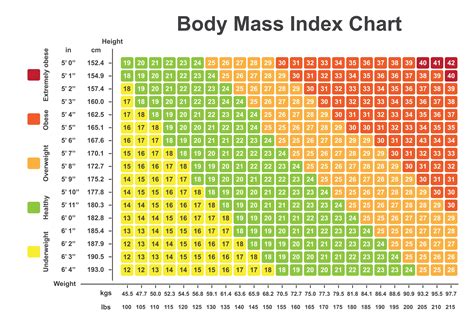
The Height, Weight, and BMI chart is a widely accessible tool that provides a quick assessment of an individual’s weight status. While it has its limitations, it serves as a valuable starting point for understanding the relationship between height, weight, and overall health. By considering the chart’s limitations and complementing it with other health assessments and professional advice, individuals can gain a more comprehensive understanding of their health and make informed decisions to improve their well-being.
How accurate is the BMI chart for assessing overall health?
+The BMI chart provides a general assessment of weight status but may not accurately reflect an individual’s body composition or overall health. It’s a useful starting point but should be complemented with other health metrics and professional advice for a comprehensive understanding.
Can I use the BMI chart to set weight loss goals?
+While the BMI chart can provide a general guideline for weight loss goals, it’s important to consult with a healthcare professional or registered dietitian to determine personalized weight loss targets based on individual health needs and goals.
Are there alternative methods to assess body composition besides BMI?
+Yes, there are several advanced methods for assessing body composition, including bioelectrical impedance analysis (BIA), dual-energy X-ray absorptiometry (DXA), and air displacement plethysmography (ADP). These methods provide more detailed insights into body fat percentage, muscle mass, and bone density.


